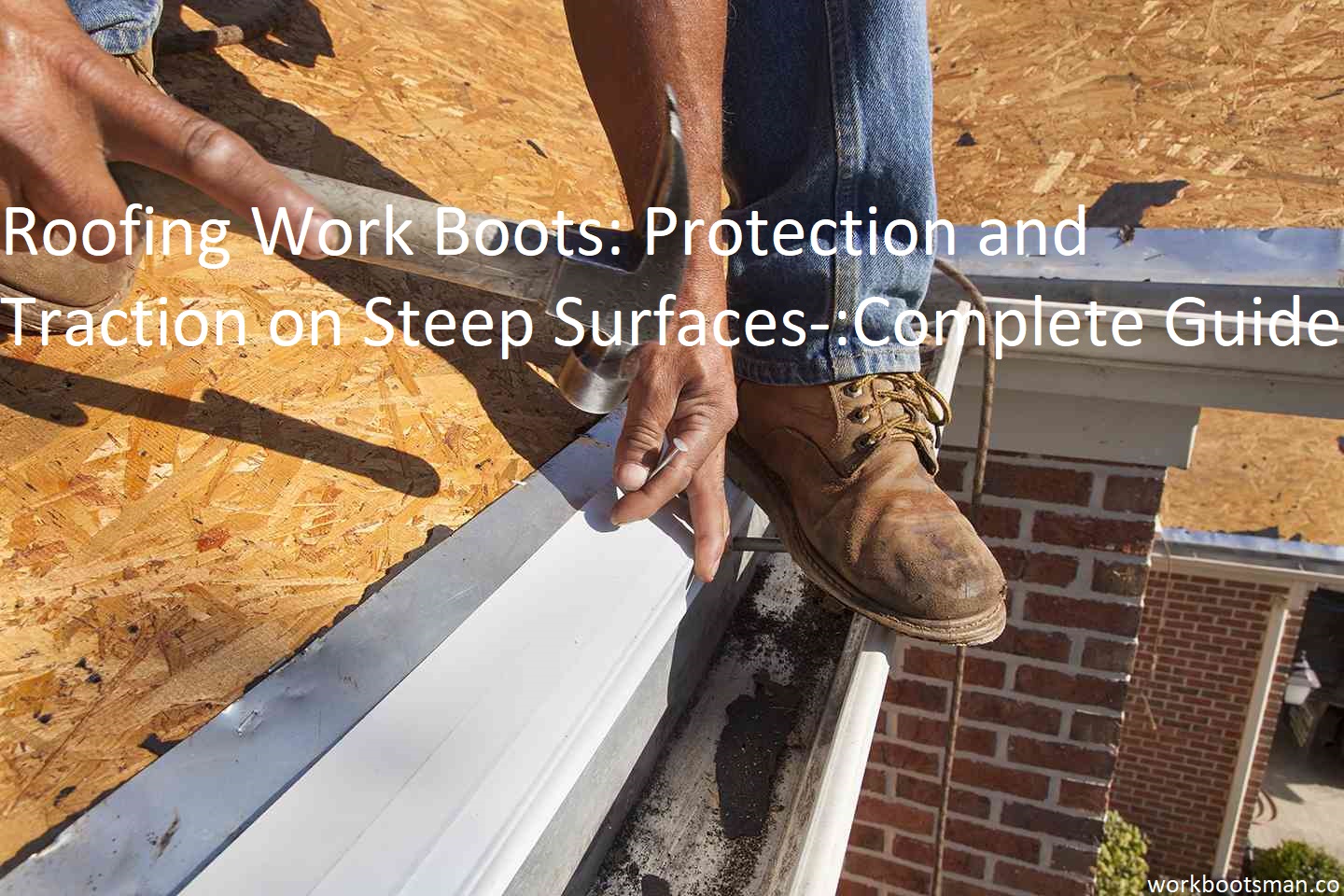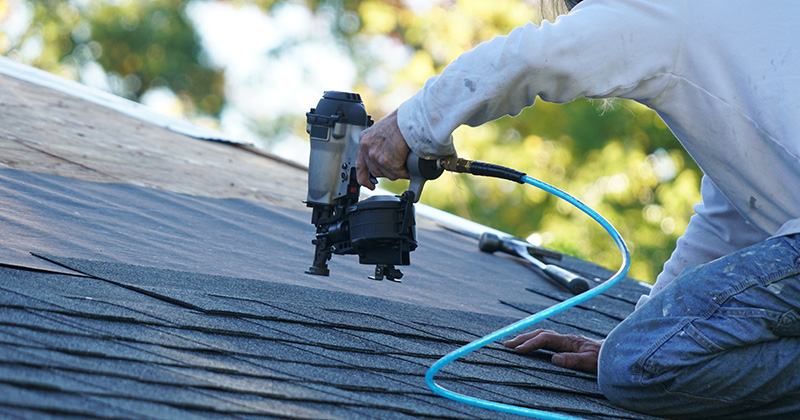Roofers are continuously exposed to some of the most hazardous work environments, making a good pair of roofing work boots essential. You need reliable protection and traction when walking steep inclines, so you can focus on the task at hand without slipping or coming down with injuries.
This guide will provide you with the key features to look for when selecting the perfect roofing work boots for maximum safety and comfort.
Roofs are often steep and slick, creating an environment that is dangerous for untrained individuals. It’s important to address the potential hazards when it comes to working on a roof. That includes having the right kind of protection on your feet.
This guide will provide you with all the information you need on roofing work boots, including why they are important and what features to look for in order to get maximum protection and traction.

Key Features of Roofing Work Boots
Having the right roofing work boots is key to staying safe while working on steep surfaces. It’s important to look for boots that provide protection, traction and flexibility.
Protection: The right pair of roofing work boots should offer ample foot and ankle protection, especially when working on slippery or uneven surfaces. Look for toe caps made of steel or composite materials, reinforced padding around the ankle and a high-traction outsole with heavy-duty treads that you can rely on when climbing onto roofs.
Traction: Depending on your work environment, you may need special grip to avoid slipping or sliding in wet or icy conditions. Outsole materials such as rubber provide good traction, but specialized treads designed for outdoor work are even better.
Flexibility: At the same time, flexible soles are essential — stiff soles can cause pain after hours of use and make certain takes more challenging. Look for lightweight design options made from synthetic leather with a flexible midsole that provides excellent cushioning without compromising flexibility and support.
Traction
When working on steep roof surfaces, good traction is essential for safety. Work boots that have lugs or ridges built into the sole are ideal for providing extra grip, so the worker can remain stable on the roof. Sturdy traction also helps protect against slips and falls when walking on wet or icy surfaces.
It’s important to consider your work environment when choosing a pair of boots with good traction. If you’ll be walking on loose gravel, soil or other materials that may move beneath your feet, then a boot with deep lugs/ridges may be necessary to ensure your safety. Additionally, work boots made of rubber and neoprene will provide better grip than leather or canvas shoes. It is also important to check that your boots fit securely so that you don’t slip out of them during work activities.
Comfort and Fit
For the safety and overall comfort of your feet, it is important to consider the fit and design of your roofing work boots. A tight fit helps keep your feet from sliding around in you boots, reducing stress on the various joints of your feet and ankles. Similarly, a roomy fit ensures that blister-causing friction is reduced when you’re climbing with a heavy load.
Additionally, look for shoes with reinforced toe caps and steel shanks to provide enhanced protection against falling debris or sharp objects. Breathable materials such as leather or nylon mesh liners are also important for improving air circulation inside of your roofing work boots, helping to keep your feet dry and comfortable throughout the day.
Many manufacturers also make purpose-built gloves so you can easily grip onto ladders and shingles while providing optimal maneuverability of your hands as well as scratch resistance on any nails or screws that may be encountered in the course of a job.
Durability

Durability is paramount when selecting your roofing work boots. You need boots that will provide sufficient slippery and traction protection, but will also last through long days and tough jobs. Remember, hard working professionals in the roofing industry will spend a great deal of time on their feet outdoors in all kinds of weather conditions, which can take its toll on even the most durable pair of shoes.
When looking for durable, reliable work boots for your next job, here are some features that can help you decide which ones are worth investing in:
- Material: Look for materials like full-grain leather and rubber soles that can withstand extended wear and tear.
- Insulation: Work boots with insulated linings are especially important when it comes to longevity. The insulation protects the feet from approaching cold weather and the perspiration associated with it.
- Stitch Quality: Strong stitching ensures your boots stay together even after months of use and abuse. High quality stitching ensures a tight seal that won’t come undone easily or prematurely.
- Thick Sole: Thick soles provide extra protection against shocks while also providing better grip throughout wet or dry surfaces.
- Thick Padding: Look for padding to cushion your feet on hard surfaces. Padding helps prevent soreness throughout long shifts on your feet all day long.
Additional Considerations
In addition to the features outlined in the previous sections, there are other factors to consider when choosing suitable roofing work boots. These include:
-Comfort: Look for features such as padded insoles and linings, as well as ergonomic design that is built for all-day wear in spite of uneven terrain and sharp angles.
-Durability: Roofing can be tough on shoes, so you need work boots that are up to the task. Look for sturdy materials that stand up to wear and tear, such as leather or other hardwearing synthetic materials.
-Climbing Aid: Depending on your roof type, some shoes may be designed with special lugs or other climbing aids to make it easier to traverse steep slopes or slippery surfaces.
-Oil Resistance/Slip Protection: It’s important to have proper footing even when working on oily surfaces. Many shoe models come with oil resistance/slip protection technology built into their soles or heels.
-Shock absorption: Working off a roof can involve significant impacts from big jumps or even falling objects from above; look for shoe models with extra padding and shock absorption capabilities to help protect your feet from these types of accidents.
Electrical hazard protection
It is essential that you choose roofing work boots that provide electrical hazard protection if you are working around harsh electricity sources. This type of boot features a rubberized sole and thick insulation to protect your feet in the event of a charge. Additionally, they should be made with durable leather material or have a non-slip outer sole for sure footing on steep surfaces.
Most of these boot models are equipped with stay flexible gel inserts to ensure your ankle can adjust when your foot hits the ground unevenly. Be sure to examine the details and make sure the electrical hazard protection meets EN ISO 20345 standards for maximum protection from dangerous electrics sources on the job site.
Waterproofing
Waterproofing is an essential feature of any shoe designed for roofing purposes. It will help keep your feet dry and protect them from hazards such as sparks, embers, and molten metal. Depending on the type of construction or job you are completing, it may be recommended that you wear a waterproof shoe or boot to provide comprehensive protection against potential threats. Waterproof boots will also increase traction on wet surfaces, making them even safer for use in rainy or humid climates.
When considering waterproofing options, it is important to note that not all shoes are created equal. Some types of footwear boast superior waterproofing capabilities, including rubber boots and PVC-coated fabric boots. These boots can generally be expected to repel water for a more extended period than a leather boot might, so it’s important to know what type of material your boot is made from before purchasing it for roofing work.
Maintenance and Care

Caring for your roofing work boots is essential to making sure that they last and work as intended. Proper maintenance will keep them in good condition and functioning properly even in difficult conditions. Here are a few tips for keeping your roofing boots going strong:
- Clean them regularly with a brush or cloth after wearing to remove dirt, mud, and other debris that can accumulate on the soles of the boot.
- Condition the leather regularly with a leather conditioner or polish to protect it from rain and harsh temperatures.
- Store your boots in a dry and cool place when not in use; this will help maintain their shape and prevent cracking of the leather over time.
- Tighten any loose straps, buckles, laces, or other pieces that may have become worn over time so that they do not become loose while you are working on roofs.
- Replace parts as needed when they become worn down; this may include laces, insoles, and midsoles if needed. This will help ensure that you remain comfortable while standing on high roofs all day long.
Proper cleaning techniques
Cleaning your roofing work boots properly is key to maintaining their performance and durability. Before cleaning your boots, read the care instructions on the label inside the footwear to make sure you don’t damage it during cleaning. Depending on the material of your work boots, you can use a variety of solutions and tools to keep them clean.
Leather Boots: You should use a leather cleaner or saddle soap and warm water for leather boots. With a damp cloth, scrub the surface in a circular motion and let it dry before applying polish or conditioner. You should also apply oil or wax for added protection against weather conditions or heavy wear.
Synthetic Materials: For synthetic materials like rubber, canvas, nylon and plastic, you can use mild detergent, warm water and a sponge to wipe down the material of your work boot. Rinse with clear warm water afterward to remove residue from soap suds and air dry away from direct heat sources such as radiators, heaters or sunlight.
Heavy Duty Work Boots: For really caked-on mud or debris that’s built up on the bottom of your boot sole use an old toothbrush with some detergent solution rubbed into a lather then gently scrub away at it until clean. Be sure not to remove too much of the tread pattern on your soles as this will reduce their traction capabilities during difficult roofing tasks. Once clean you can let it air dry in indirect contact from sunlight or direct sources of heat mentioned above before wearing again!
Inspection and replacement of worn-out parts
Once you’ve decided on a pair of roofing work boots, it is important to inspect them carefully before each use. Not only is this necessary in order to keep them in the best condition, but it ensures that any worn-out parts can be fixed or replaced before they compromise the safety of your feet.
Start by checking for signs of wear on the toes and heels such as scuffs and cracks. Look for any loose stitching; a fractured seam is an indication that the boot may be ready for replacement. If there’s evidence that the boot does not fit correctly, it can cause loss of support or instability during exercise on steep surfaces and should be replaced immediately.
Checking the tread depth of your soles is another essential component to make sure your boots provide adequate traction on icy or slippery surfaces. Replace soles when they become worn down as they can no longer grip surfaces efficiently which could endanger your ability to remain balanced while working outdoors.
Also, inspect your laces with care: look for frayed ends, rips and tears so you can replace them accordingly if needed. Make sure they are tied properly so they don’t rub against your ankles as this might cause blisters or skin abrasions which could lead to an infection if untreated. Taking care to inspect these small components may help prevent injuries and ensure safety while maintaining optimal performance during roofing tasks.
Storage and maintenance tips
Proper care of roofing work boots is essential to ensure worker safety and proper working conditions. Work boots should be regularly cleaned and stored away from heat and humidity to reduce the likelihood of cracks, splits, punctures or damage to the boot material. Here are important tips on how to store and maintain work boots:
- Clean all dirt, mud, salt and debris off your work boots before storing them away in a cool, dry place.
- Stuff the toes of shoes/boots with newspaper or other absorbent material when not wearing them. This will help them keep their shape when not in use.
- Polish or shine your leather or synthetic shoes regularly if you prefer for cosmetic reasons, but it’s important to remember that only regular cleaning can help maintain the waterproof properties of your boots for longer-term performance.
- Apply leather conditioner once a month on any leather material to prevent it from drying out or cracking over time due to wear and tear from harsh environments like snow, rain or mud.
- Use a leather/synthetic conditioner on all upper fabric materials like mesh as it helps keep abrasion resistance up while extending garment life considerably.
- For composite toe caps use a simple damp cloth occasionally and soapy water with only light pressure as needed – this will help prevent any corrosive agents building up on the cap’s surfaces which could reduce its protection ability over time.

Conclusion
In conclusion, finding the right work boots for roofing tasks is essential for ensuring the safety and comfort of any worker. Keep in mind that a good fit is necessary – try on different sizes and styles until you find one that feels most comfortable. Pay attention to the protective qualities of your footwear such as slip resistance, durable material and a secure fit. Consider special features like added insoles or extended durability if they provide a benefit.
And finally, be realistic when it comes to cost – expensive models are normally more reliable and well-made than budget alternatives. Investing in quality roofing work boots will provide improved performance, better traction, and overall greater satisfaction with your roofing job.
FAQs
What type of boots do roofers wear?
Roofers typically wear specialized roofing boots that are designed to provide excellent traction on various types of roofing materials.
What are roofing boots?
Roofing boots are specialized footwear that are designed for use by roofers. They typically have a high ankle support, slip-resistant soles, and are made from materials that can withstand exposure to hot asphalt and other roofing materials.
What kind of shoes do you need to walk on a roof?
To walk on a roof, you need shoes or boots with excellent traction and grip, as well as good ankle support. Ideally, they should also have a flat sole to prevent any damage to the roofing material.
How do you walk on a steep roof?
To walk on a steep roof, it’s important to have the proper safety equipment, including a harness and a safety line. It’s also important to take small, deliberate steps and to keep your weight centered over your feet.
How do you access a steep roof?
Accessing a steep roof typically involves using a ladder, but in some cases, it may be necessary to use scaffolding or a hydraulic lift.
How do you get traction on a metal roof?
To get traction on a metal roof, it’s important to wear boots or shoes with slip-resistant soles, and to take small, deliberate steps. It may also be helpful to use a safety line to prevent slipping.
What boots are best for work?
The best boots for work depend on the specific job and the conditions in which they will be worn. However, in general, work boots should be comfortable, durable, and provide good support and protection for the feet.
What are construction boots called?
Construction boots are often called work boots or safety boots. They are designed to protect the feet and provide support and stability for workers on construction sites.
What boots to wear on all weather pitch?
On an all-weather pitch, it’s important to wear boots with a good grip and traction. Football boots or soccer cleats are often a good choice, as they are designed specifically for use on grass or artificial turf.
What is safety boots in construction?
Safety boots in construction are designed to protect the feet and provide support and stability for workers on construction sites. They are typically made from durable materials and feature a steel toe cap to protect against impacts and other hazards.
See Also:
- Best work boots for landscaping 2023
- Best work boots for mud 2023
- Best zipper work boots 2023
- Best irish setter work boots 2023
- Best work boots for neuropathy 2023

